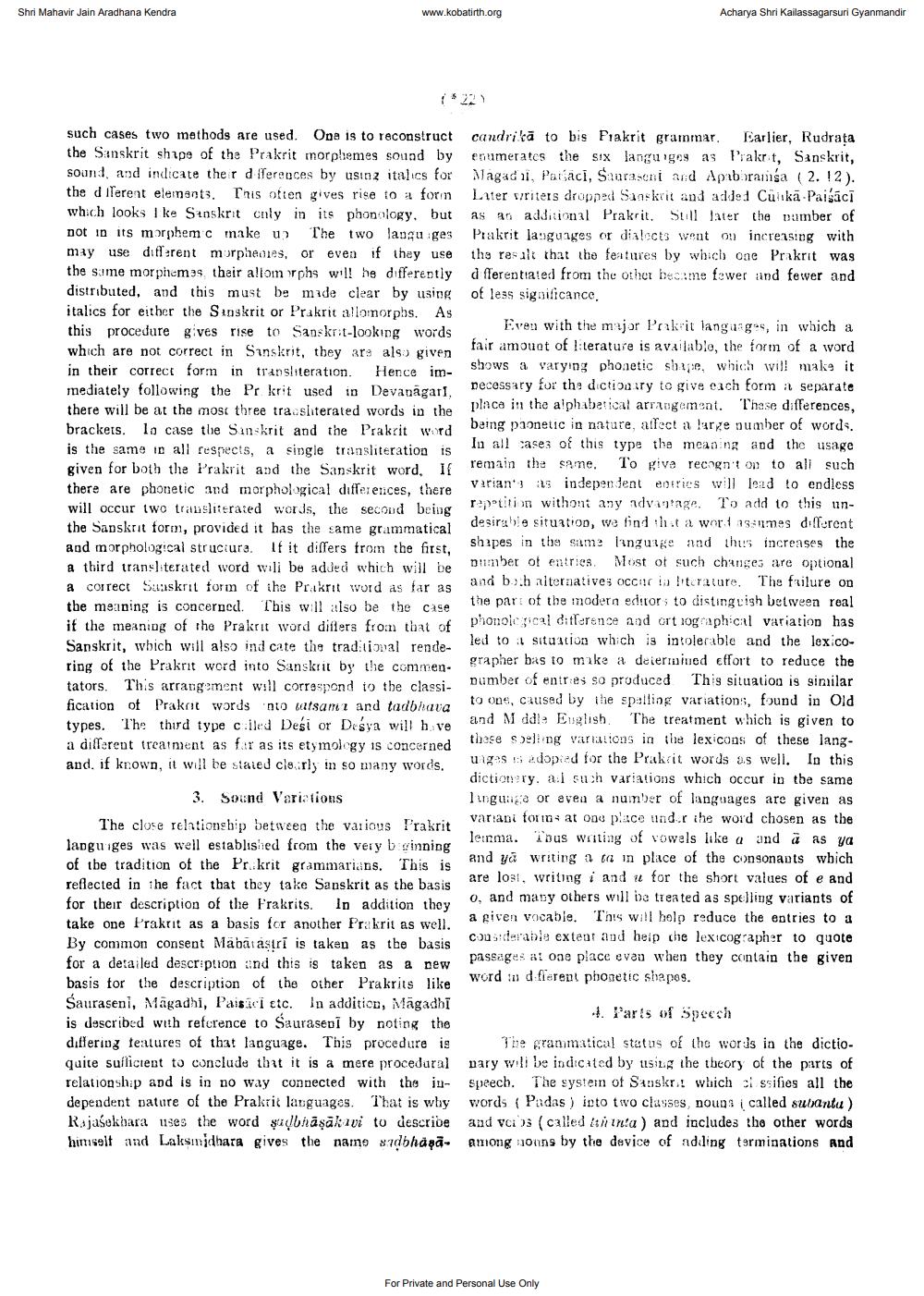________________
Shri Mahavir Jain Aradhana Kendra
www.kobatirth.org
Acharya Shri Kailassagarsuri Gyanmandir
such cases two methods are used. One is to reconstruct candrikā to bis Prakrit grammar. Earlier, Rudrata the Sanskrit shape of the Prakrit morphemes sound by enumerates the six langugog as Prakrt, Sanskrit, sound, and indicate their difereeces by using italics for Magadan, Paraci, Saurason and Apabransa (2. 12). the di Terent elements. This often gives rise to a form Later writers droppex Sanskrit and adde:1 Cütikā. Paigāci which looks I ke Sanskrit cnly in its phonology, but as an additional Prakrit. Still later the number of not in its morphemc make u The two languges Prakrit laoguages or dialects went ou increasing with may use different murphecies, or even if they use the result that the features by which one Prakrit was the same morphem as their allomrphs will he differently d fferentiated from the other became fewer and fewer and distributed, and this must be made clear by using of less significance. italics for either the Sanskrit or Prakrit allomorphs. As this procedure gives rise to Sanskrit looking words
Even with the major Prakrit languages, in which a which are not correct in Sanskrit, they are also given
fair amount of literature is available, the form of a word in their correct form in transliteration. Hence im
shows a varying phonetic shape, which will make it mediately following the Pr krit used in Devanagari,
necessary for the dictiary to give each form it separate there will be at the most three trausliterated words in the
place in the alphabetical arrangement. These differences, brackets. lo case the Sanskrit and the Prakrit word
being paonetic in nature, affect a large oumber of words. is the same in all respects, a single transliteration is
In all cases of this type the meaning and the usage given for both the Prakrit and the Sanskrit word, If
remain the same. To give recogn't on to all such there are phonetic and morphological differences, there
variant as independent eotries will lead to endless will occur two transliterated words, the second being
repetition without any advantage. To add to this unthe Sanskrit form, provided it has the same grammatical
desirable situation, we find that a wort :umes different and morphological structura. If it differs from the first,
shapes in the same language and thus increases the a third transliterated word wili be added which will be
number of entries. Most of such changes are optional a correct Swaskrit form of ihe Prakrit word as far as
and bih riternatives occur in literature. and
The frilure on the meaning is concerned. This will also be the case
the part of the modera editors to distinguish between real
the par it the meaning of the Prakrit word differs from that of
+ phonological difference and ortographical variation has Sanskrit, wbich will also ind cate the traditional rende
led to it situation which is intolerable and the lexicoring of the Prakrit word into Sanskrit by the commen.
grapher bas to make a deiermuined effort to reduce the tators. This arrangement will correspond to the classi
number of entries so produced This situation is similar fication of Prakrit words into tatsame and tadbhava
to one, caused by the spelling variations, found in Old types. The third type ciiled Desi or Desya will have
and M ddl, Euglish. The treatment which is given to a different treatment as far as its etymology is concerned
these spelling vartalons in the lexicons of these langand if known, it will be stated clearly in so many words.
uigass dopied for the Prakrit words as well. In this
dictionary, al such variations which occur in the same 3. Sound Variations
linguna or even a number of languages are given as
variani for at one place under the word chosen as the The close relationship between the various l'rakrit languiges was well established from the very b winning
leinma. Tous writing of vowels like aand ä as ya
and ya writing a ta in place of the consonants which of the tradition of the Prikrit grammarians. This is reflected in the fact that they take Sanskrit as the basis
are lost, writing i and it for the short values of e and for their description of the Frakrits. In addition they
o, and many others will be treated as spelling variants of
a given vocable. This will help reduce the entries to a take one Prakrit as a basis for another Prakrit as well. By common consent Mabatastri is taken as the basis
considerable extent and help the lexicographer to quote
passages ai one place even when they contain the given for a detailed description and this is taken as a new
word in difierent phonetic shapes. basis for the description of the other Prakrits like Sauraseni, Magadhi, Paisici etc. In addition, Māgadbi
. Parts of Speech is described with reference to Saurasevi by noting the differing features of that language. This procedure is The grammatical status of the words in the dictioquite suflicient to conclude that it is a mere procedural Dary will be indicated by using the theory of the parts of relationship and is in no way connected with the in- speech. The system of Sanskr.! which ci ssifies all the dependent pature of the Prakrit larguages. That is why words ( Padas ) into tivo classes, nous called subantu ) Rajasekhara uses the word sudbāşākivi to describe and vis (called ai inta) and includes the other words himselt and Laksmdhara gives the name sodbhasa among nonns by the device of adding terminations and
For Private and Personal Use Only




